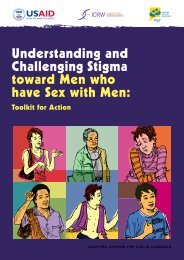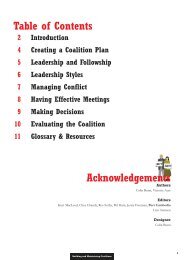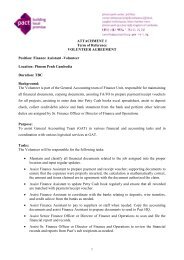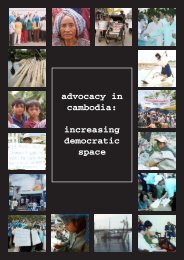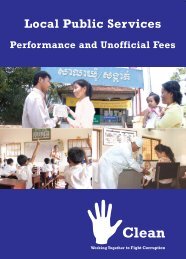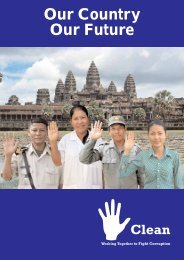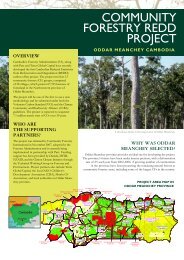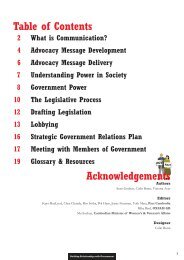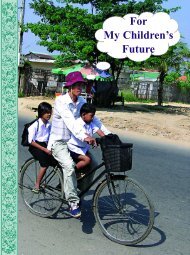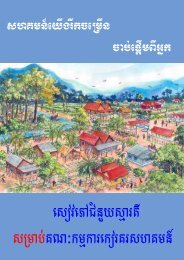Advocacy - Module 6 - ENGLISH.pdf - Pact Cambodia
Advocacy - Module 6 - ENGLISH.pdf - Pact Cambodia
Advocacy - Module 6 - ENGLISH.pdf - Pact Cambodia
You also want an ePaper? Increase the reach of your titles
YUMPU automatically turns print PDFs into web optimized ePapers that Google loves.
ADVOCACY<br />
e x p e r t s e r i e s<br />
6<br />
Community Mobilization
<strong>Advocacy</strong> Expert Series<br />
Book 6<br />
Community Mobilization<br />
Edition 1<br />
© October 2006<br />
Publication #10-2006<br />
We encourage you to copy part or all of this guide and to share it with others.<br />
Printed by Sunway Publishing Shop<br />
#31, St. 302, Boeung Kengkang I, Chamkarmon, Phnom Penh, <strong>Cambodia</strong><br />
Tel:(855-23) 996 725, Mobile: (012-011-016) 82 81 00<br />
The <strong>Advocacy</strong> Expert Series is a set of educational publications developed by the <strong>Advocacy</strong> and Policy Program at <strong>Pact</strong><br />
<strong>Cambodia</strong> that explores the principles, strategies, and techniques of effective advocacy campaigns. Titles in the<br />
<strong>Advocacy</strong> Expert Series include:<br />
Book 1: <strong>Advocacy</strong> Campaign Management<br />
Book 2: Building Relationships with Government<br />
Book 3: Working with the Media<br />
Book 4: Building and Maintaining Coalitions<br />
Book 5: <strong>Advocacy</strong> through Legal Services<br />
Book 6: Community Mobilization<br />
Community Mobilization
Table of Contents<br />
2 Introduction<br />
3 Our Rights in the Community<br />
4 What is a Community?<br />
5 Mobilizing to Solve Your Community’s Problems<br />
6 Why Work Together?<br />
7 Form the Core Group<br />
12 Educate and Energize Your Community<br />
13 Find Allies<br />
14 Take Collective Action<br />
15 Conclusion<br />
16 Tactics of Advocates Around the World<br />
17 Additional Resources<br />
Acknowledgements<br />
Authors<br />
Victoria Ayer, Chhuon Vuthy,<br />
Kem Sambaddh, Sok Sambath, Neb Sinthay<br />
Editors<br />
Kurt MacLeod, Keo Keang, Yoib Meta,<br />
Chea Sopheap, Lam Socheat, Ny KeoPonha<br />
Designer<br />
Phan Phorp Barmey, Sean Simons<br />
Community Mobilization
Introduction<br />
In an ideal world, governments provide services efficiently, corporations behave responsibly, and people treat each other<br />
with fairness and respect. However, we know that every day communities struggle to get their basic needs met, natural<br />
resources are exploited for profit, and individuals face discrimination. This handbook provides a few techniques and<br />
methodologies to assist community activists challenge these problems by mobilizing people into advocacy campaigns.<br />
Through a rights-based approach, activists can help their family, friends and neighbors secure their rights and receive<br />
better social services.<br />
2<br />
Community Mobilization
Our Rights in the Community<br />
Community people have the right to advocate for better access to land, fishing lots, forests, health, education and other<br />
services. These rights are protected by the <strong>Cambodia</strong>n Constitution.<br />
The term "rights-based approach" is often used to describe problem-solving campaigns that are based on a community's<br />
needs. What does this term really mean?<br />
A rights-based approach means empowering people to understand and exercise their rights. At the same time, government<br />
is expected to fulfill its duties. Generally, we divide people into two main groups: Rights-holders and Duty-bearers.<br />
Rights-holder: This term means individuals and groups who have particular entitlements.<br />
For example, every child in <strong>Cambodia</strong> has a right to receive free education. All <strong>Cambodia</strong>ns<br />
have the right to be free from torture by the police. Sometimes, people's rights are not<br />
respected and people must work hard to get their rights.<br />
A rights-based approach encourages the respect and fulfillment of human rights and also requires active participation<br />
by people to secure their own rights and monitor the government's actions.<br />
Duty-Bearers: These are people who have a responsibility<br />
to protect, promote, and realize particular human rights.<br />
They also have a responsibility not to violate people's<br />
human rights. Usually, these are elected or appointed people<br />
in the government: police, judges, parliamentarians,<br />
bureaucrats, even the Prime Minister.<br />
Government has a duty to fulfill its obligations to the people. Government's responsibility to provide education, health<br />
care, and protect human rights is not based on whether a person has a personal relationship with a government official.<br />
People should receive basic services because they are rights, not gifts.<br />
Community Mobilization<br />
3
What is a Community?<br />
A community is a group of people living in the same area (e.g., village, commune, town, city, or urban areas), sharing<br />
social relationships and having a common interest.<br />
All communities should help identify and mobilize their own resources efficiently. It is important that when an issue is<br />
identified, all members of the community are invited to become involved in discussing, learning, analyzing, sharing ideas,<br />
and taking action together to solve their problems in order to build a community's self-reliance, self-sufficiency and<br />
improve their lives.<br />
4<br />
Community Mobilization
Mobilizing to Solve<br />
Your Community's Problems<br />
This handbook divides the process of activating and mobilizing your community into five steps:<br />
Why work<br />
together?<br />
Take<br />
Collective<br />
Action<br />
Form the<br />
Core Group<br />
Find Allies<br />
Educate and<br />
Energize Your<br />
Community<br />
Community Mobilization<br />
5
1<br />
Why work together?<br />
By working together to solve their own problems,<br />
a community can:<br />
- Build more unity and solidarity among their members<br />
- Promote collective decision-making, which is more likely to peacefully<br />
resolve conflict and may prevent conflict from happening<br />
- Create pressure on duty-bearers/decision-makers to deliver services<br />
- Change policies or laws that affect the community.<br />
To achieve these expectations, the community, or Core Group, needs to work closely together and continually look to<br />
develop connections with, and gain support from, existing and potential allies.<br />
Challenges for communities who mobilize to solve their own problems:<br />
- People may face physical or economic dangers when they claim their rights<br />
- It may be difficult to convince enough people to participate<br />
- Energizing people and resources to fight the problem may take a lot of time<br />
- People have different perceptions and levels of commitment, which may lead to disagreements<br />
- It may take a long time to overcome<br />
bureaucratic systems within government.<br />
To address the community's<br />
needs, problems, and challenges,<br />
you must form a core group of<br />
committed people to lead and<br />
facilitate discussion, sharing,<br />
analyzing, and taking action<br />
together.<br />
6<br />
Community Mobilization
2<br />
Form the Core Group<br />
In the beginning, people in your community may not feel the same urgency that you feel about solving the problem.<br />
Many times, they will not even believe there is a problem. Convincing people to become involved is a difficult task but<br />
your community's problem was created by more than one person and you will need many people working together to<br />
solve it.<br />
At first, you will want to organize a small core group of people to work<br />
together. This core group will be responsible for gathering data about<br />
the problem and creating a long-term strategy. Finding effective leaders<br />
and followers is an important step in solving your community's problem.<br />
Leaders come from many places and do not always hold any formal<br />
positions in the community. A good leader is able to express deep<br />
feelings and impress upon others that a problem exists and that something<br />
needs to be done about it. This leader will create the energy needed<br />
to educate and mobilize the community. This leader may be you!<br />
Characteristics of Leaders and Followers<br />
Good Leaders<br />
Good Followers<br />
- Speak persuasively<br />
- Motivate others in a respectful way<br />
- Take risks<br />
- Delegate significant tasks to followers<br />
- Help resolve conflicts<br />
- Encourage creative problem-solving<br />
- Share information<br />
- Accept responsibility for their actions<br />
- Communicate and inspire<br />
- Are self aware and principled<br />
- Believe that power is best employed if shared<br />
- Seek ways to accomplish goals in harmony<br />
with leader's vision<br />
- Use creativity, knowledge, and insight to take<br />
initiative and respond quickly<br />
- Have loyalty to the community and the willingness<br />
to act according to their beliefs.<br />
- Understand the community and their contributions<br />
to it<br />
- Are versatile and flexible enough to adapt to<br />
a changing environment.<br />
- Take responsibility for their own actions and<br />
their own ideas<br />
Community Mobilization<br />
7
Recruiting Members of the Core Group<br />
Of course, it is important to involve many people with different capabilities and skills in your effort. But the core group<br />
needs certain types of people. In order to maximize your chance for success, you should try to build upon people's natural<br />
tendency to imitate people they admire. Your core group should contain people from your community who act as<br />
the:<br />
______________________________________<br />
_____________________________________<br />
Brain<br />
Other people ask for reliable advice.<br />
______________________________________<br />
_____________________________________<br />
Heart<br />
Have connections to many people and enjoy creating alliances among people.<br />
______________________________________<br />
_____________________________________<br />
Mouth<br />
Speak persuasively and cause other people to change their opinions or habits.<br />
After you identify these three types of people, speak with them. At first, they may not understand your issue or problem.<br />
It is your job as a community activist to explain why it important to act now and offer good reasons why they<br />
should join your cause.<br />
W<br />
henever a group of people work together, there may be some struggles or conflicts.<br />
Different levels of expertise may cause people to feel jealous of others' ability. Different<br />
levels of commitment may cause people to feel resentful if they believe some people are being<br />
lazy. As much as possible, make sure everyone feels like their contribution-whether it is big or<br />
small - is important. Rotate leadership roles by allowing different people to act as chairperson of<br />
a meeting or organizer of an event. To avoid one or two people dominating conversations, set a<br />
time limit for how long people may speak. Recognize and praise people's suggestions and ideas,<br />
even if they contradict your own. Use democratic techniques - like voting - to arrive at solutions<br />
or agreement.<br />
8<br />
Community Mobilization
Identify the Problem<br />
Your Core Group should now conduct some basic research and gather information on the way this problem affects your<br />
community. Understanding the problem will help you persuade more community members to join your cause and give<br />
you evidence that you can present to decision makers or the media. Remember, accurate information is better than gossip.<br />
People in powerful positions cannot easily ignore solid evidence.<br />
An example :<br />
Problem: Most of the families in our village, Phum Svay, are poor farmers. The<br />
Government has granted a land concession to a foreign company in a neighboring<br />
village. Without consultation, the company built a road and fence near our village.<br />
One of our village elders has obtained a copy of the company's plan, which<br />
indicates that they will seize land in Phum Svay next.<br />
Basic research could<br />
involve activities such<br />
as meeting with individuals<br />
and groups,<br />
and carrying out surveys.<br />
First Step: Create a community map of how the possible land dispute will affect people. Go to each household<br />
and ask::<br />
- How many hectares of land does<br />
your family own? Grow crops on?<br />
- How would the loss of any land<br />
affect your family life?<br />
- Are there any changes your family<br />
would have to make if you lost any<br />
income? Would you still eat the same<br />
amount of rice? Would all of your<br />
children go to school?<br />
- Do you think you could go to anyone<br />
for help to solve this problem?<br />
If not, why?<br />
Make sure your interviewers are sensitive and polite when conducting the interview. Many people are embarrassed<br />
about their inability to share experiences, speak out, or dialogue with you. People may not be motivated to discuss<br />
the land issue openly because they fear retribution by the company or believe that the local authority is rude<br />
or corrupt. Make sure that your interviewers get a full understanding of the whole situation.<br />
Community Mobilization<br />
9
After you have collected the data, make a map:<br />
A Community Map of Phum Svay<br />
Sarin has one leg. He has five children. He has 0.5<br />
hectare for growing seasonal vegetables and rice.<br />
If any of his land was seized, his family would be<br />
forced to leave the land and house.<br />
Sok's family has one<br />
hectare of land for growing<br />
fruit trees and seasonal<br />
vegetables. He has 6 children.<br />
The main income for<br />
his family is farming this<br />
land. All of his land could<br />
be seized by the company.<br />
Yeoun has 4 children and an elderly mother. She has only 0.5 hectare of<br />
land for growing rice and she tries to grow rice two times per year.<br />
About half of her land could be seized by the company. If her land is<br />
seized, she could no longer afford to send her youngest daughter to school.<br />
After you have collected your data, you should ask some questions in your Core Group: What is the potential impact on<br />
your community? How many people would go hungry if their land was seized? How many children could no longer go<br />
to school? How many families would have to move? How many people own title to their land? How many people could<br />
own title to their land if they had the proper documents or information? How many people are living illegally?<br />
In this example, the Core Group decided that the real problem was the lack of consultation with the people about the<br />
land concession and the lack of information about getting title to the land. The Core Group decided they needed to<br />
focus their efforts on demanding the rights to live, and possess land where they have lived for many years.<br />
Researching Your Problem<br />
While you research your community's problem, check to see if the <strong>Cambodia</strong>n government has already agreed on a solution.<br />
Ask your commune councilor, local ministry official, or Prime Minister's cabinet if you need more information.<br />
Maybe there is already a local government or national policy or law that will help you. The easiest solution to implement<br />
is one that already exists.<br />
In addition, you should know that the <strong>Cambodia</strong>n Government has already agreed to respect many fundamental rights<br />
of the people, such as civil rights, political rights, economic rights, social rights and cultural rights. More information on<br />
international human rights documents is available at the end of this manual.<br />
Sometimes, you may discover that you have more information or knowledge than the responsible government official<br />
does. Many people are elected or appointed to their position because of loyalty to their political party rather than expertise<br />
in the issue. This is a normal situation around the world. However, it is no excuse for not taking action. Remember<br />
that you are a rights-holder. Part of your responsibility is to understand and demand your rights. If a duty-bearer fails<br />
to respect your rights, you have two powerful weapons - your voice and your vote.<br />
10<br />
Community Mobilization
Create a Strategy<br />
Once you have analyzed your research, your Core Group needs to create a strategy which should clearly identify:<br />
- The problem and the behavior that needs to change<br />
- What activities you will do and what resources you will need<br />
- Who in the media to contact<br />
- Which public officials and allies you should meet<br />
Remember to clearly identify who will take responsibility for each task and set deadlines for when work must be completed.<br />
Strategy to Mobilize Our Community to Protect Our Land<br />
What We<br />
Will Do<br />
When We<br />
Will Do It<br />
What Do We Need?<br />
Who is<br />
Responsible?<br />
Organize a meeting<br />
with Commune<br />
Council<br />
Immediately<br />
- Send letter to the Commune Council office to request for<br />
a meeting.<br />
- Prepare an agenda and decide who should attend the meeting.<br />
- Bring a copy of community map to meeting. Ask for the<br />
commune councilors´ help to arrange a meeting with the<br />
company.<br />
Socheat<br />
Go on radio talk<br />
shows to discuss<br />
the possible landgrabbing<br />
and your<br />
demands to register<br />
your land by using<br />
the Land Title Law<br />
One week from<br />
now<br />
- Contact radio station<br />
- Choose Spokesperson who will go on the radio.<br />
- Prepare a speech and practice answering questions<br />
- Have volunteers ready to call into radio station with questions.<br />
Sopheap<br />
Art contest for<br />
school students on<br />
title: Our Land,<br />
Our Life for My<br />
Begin in two<br />
weeks<br />
- Have volunteers talk with and get permission to go to the<br />
school and announce to students.<br />
- Post art contest results at commune council office.<br />
Meta<br />
Community!<br />
- Volunteers go to houses and encourage villagers to participate<br />
and assist villagers in understanding registration<br />
requirements.<br />
Organize land reg-<br />
- Contact relevant land registration office to send a repre-<br />
istration day to<br />
sentative.<br />
ensure all villagers<br />
In one month<br />
- Ask local authority's permission for organizing the event.<br />
Sinthay<br />
legally register<br />
- Assign people to be responsible for security and logistics.<br />
their land<br />
- Invite the media to the event and choose one or two representatives<br />
to talk with the media.<br />
- Submit land registration documents to the proper government<br />
office.<br />
11<br />
Community Mobilization
3<br />
Educate and Energize Your Community<br />
When confronted with a difficult problem, many people avoid trying to find a solution. This may seem strange but it<br />
is a natural human response to avoid conflict, especially if you cannot see how your situation will improve. You might<br />
even believe that if you try to change the situation, you or your family will be harmed or threatened.<br />
Helping people realize and understand why they need to take action is called "consciousness-raising". As a community<br />
activist, you can help raise people's consciousness by:<br />
o encouraging group dialogues among people who may share the same problem<br />
o speaking with people about how their lives will be better if they work to change the situation<br />
o discussing and finding ways to address and solve their community problem.<br />
Example: Host a Community Meeting<br />
The Core Group believes that unless action is taken, the company will seize land from villagers in Phum Svay. To energize<br />
people, the Core Group gathered together people for an afternoon meeting. The Core Group wanted people to<br />
honestly share their stories and experiences. This was not a time for criticism but for sharing concerns and insights and<br />
building strong solidarity among people.<br />
One member of the Core Group facilitated the meeting by asking questions like: Has anyone been told by the company<br />
that they must leave their land? How is this potential conflict affecting villagers' lives? Has anyone been threatened?<br />
How can we work together to peacefully resolve this conflict? Who should we talk to and get support from? How many<br />
people understand the Land Law? How many people have registered their land and have a Land Deed?<br />
After listening to everyone's experiences, the Core Group asked participants to name people who were able to resolve<br />
the issue. Everyone agreed that though many people had influence - friends, neighbors, teachers, elders - the most<br />
important were the commune council, district, and provincial authorities in charge of land registration. So the Core<br />
Group decided it was most important to encourage villagers to register<br />
their land. The Core Group also thought that the commune<br />
council should meet with the company to discuss the concession.<br />
Though people expected that the commune council would support<br />
them, everyone was concerned that the Government would not<br />
change the concession unless there was outside pressure from the<br />
public. One member of the group suggested that the<br />
local radio show be contacted as well as the newspapers<br />
in Phnom Penh. The villagers agreed and suggested<br />
that the most convincing message to gain the<br />
support of their neighbors was:<br />
"It's our land,<br />
it's our right. Don't<br />
steal the food from<br />
our bellies and our<br />
babies!"<br />
Once people have finished sharing their stories and experiences, it is very important that you ask people in the<br />
group to tell you which words, phrases or ideas they believe are most convincing to encourage other people to support<br />
and work together to solve this problem. Pick a phrase or two that you can say in 30 seconds or less. This is<br />
your core group's "Message". Whenever a member of your Core Group attends a community meeting, speaks with<br />
a public official or neighbor, or talks to the media, they should try to state the "Message" at least twice during their<br />
conversation.<br />
12<br />
Community Mobilization
4 Find Allies<br />
Once people hear the Core Group speaking in the community, they will<br />
be interested in joining your cause. They may not have the time or energy<br />
to work as hard as you but remember that we need as many people to be<br />
involved as possible. Creating change is hard work and goes faster with many<br />
hands. Imagine that you are a pebble thrown into a pond. One pebble creates<br />
a few ripples that fade away. Many pebbles create a wave.<br />
Remember to look for resources outside your community. If your community<br />
is having a problem, it is very likely that other communities have a<br />
similar problem. They may have thought of an innovative solution or they<br />
may want to join your effort to create change.<br />
Though Community Mobilization<br />
should encourage selfreliance,<br />
sometimes, we<br />
need to find people<br />
outside our community<br />
- NGOs, government,<br />
the media - in order to<br />
get resources and make<br />
our change happen.<br />
Note: As your community<br />
becomes interested in helping<br />
to solve the problem, more<br />
people will join. In expanding<br />
the membership of the Core<br />
Group, the community should<br />
be encouraged to identify those<br />
people who they believe would<br />
make the most positive impact.<br />
Protect Our Land: Finding Allies<br />
The Core Group decided that they needed an activity that would<br />
attract attention of the media. At one meeting, someone suggested<br />
that schoolchildren might have some good ideas on why and how<br />
we should claim our land rights. The Brain and the Mouth got permission<br />
from the principal to speak with the schoolchildren, their<br />
parents and teachers.<br />
Before contacting others, we should be clear<br />
on what we can do and what we think they<br />
can do.<br />
<br />
<br />
<br />
<br />
<br />
<br />
<br />
<br />
How an NGO might help you:<br />
Build the capacity of the Core Group and community members<br />
Foster links between the community and government officials and members<br />
of the Senate and National Assembly<br />
Lend a constant and informed voice to the legislative drafting process<br />
Creating linkages to other communities in different parts of the country<br />
Resources: Materials, Technical Assistance, and Finance<br />
Conducting complex research, such as surveys or legal research<br />
Creating linkages to other countries<br />
Providing legal service<br />
While many NGOs<br />
practice good methods<br />
that encourage communities<br />
to gain experience,<br />
some NGOs believe only<br />
they have the knowledge to<br />
solve your problem.<br />
NGOs should not lead the<br />
effort directly. Instead,<br />
NGOs should assist the<br />
community to peacefully<br />
solve their own problems.<br />
Community Mobilization<br />
13
5<br />
Take Collective Action<br />
Depending on the problem, you can choose from many different types of actions. You do not have to spend a lot of<br />
money or organize big events. Instead, concentrate your limited time and resources on<br />
actions that are most likely to reach the people whose behavior you want<br />
to change. These are just a few possible actions you could take:<br />
- Interview on a local radio show or local newspaper.<br />
- Host community<br />
meetings or dialogues.<br />
If your problem needs<br />
legislation or regulation<br />
to solve it, encourage a<br />
commune councilor or government official<br />
to attend or even facilitate the meeting. Meet with them in advance to<br />
make sure they understand (and agree with) your position.<br />
- Organize a "Let's Talk" day. Every month, set aside one day when all of your activists<br />
- your Core Group and volunteers - go to a new person's house to talk about your community's problem.<br />
If the person becomes interested, ask them to volunteer<br />
for your cause or at least suggest names of their friends who<br />
might be interested in speaking with you. Be respectful of people<br />
and realize that their time is valuable. If a farmer is busy<br />
harvesting or planting rice, she will not appreciate being interrupted<br />
and will not listen to your Message.<br />
- Sponsor a fun activity for the community. Plan the activity<br />
to take place when there is a holiday so many people are<br />
around and feeling social. Invite the media to attend. Take<br />
photographs and recruit volunteers<br />
After speaking with the students, the Core Group<br />
in Phum Svay decided to sponsor a student's art<br />
contest. The theme of the contest was: "Our<br />
Land, Our Life for My Community". All of the<br />
students' drawings were put on display at the<br />
commune council office and other public places.<br />
People in the community placed their<br />
thumbprints on a piece of paper next to the<br />
drawings in order to vote for their favorite. The<br />
media were invited to the awards ceremony for<br />
the best drawing.<br />
- Active Non-Violence. If people with the power to solve<br />
your community's problem do not listen or refuse to hear<br />
from you, you may need to act more forcefully to get<br />
their attention. Marches and rallies require a lot of<br />
organization but as history has shown, peaceful protests<br />
are not passive. In early 2006, the Prime Minster of<br />
<strong>Cambodia</strong> was forced to release five human rights<br />
activists who were imprisoned on spurious allegations of<br />
defamation, due to broad and sustained pressure from<br />
the public.<br />
14<br />
Community Mobilization
Conclusion<br />
Mobilizing a community to face and solve a problem is not an easy task. Often, you are asking people to change behavior<br />
that they believe is normal or even required by their culture. A good strategy requires patience, persistence, and creativity.<br />
"The future depends on what we do in the present"<br />
Mahatma Gandhi<br />
Special Thanks to<br />
1. Mr. Chum Narin, Sor Sor Troung<br />
2. Mr. Chhith Sam Ath, NGO Forum<br />
3. Mr. Khuon Narin, Prom Vihea Thor (PVT)<br />
4. Mr. Lao Ly, Support Association for Rural Farmers (SARF)<br />
5. Mr. Mey Sovannara, LICAHDO Phnom Penh<br />
6. Mr. Oeung Jeudy, CHRAC<br />
7. Mr. Samreth Uth, Environment Protection and Development Organization (EPDO)<br />
8. Mr. Yoib Meta, Mr. Lam Socheat, PACT<br />
Community Mobilization<br />
15
ADVOCATE<br />
Formal Statements<br />
Public Speeches<br />
Letters of opposition or support<br />
Declarations by organizations and institutions<br />
Signed public statements<br />
Declarations of indictment and intention<br />
Group or mass petitions<br />
Communications with a Wider Audience<br />
Slogans, caricatures, and symbols<br />
Banners, posters, and displayed communications<br />
Leaflets, pamphlets, and books<br />
Newspapers and journals<br />
Records, radio, and television<br />
Skywriting and earthwriting<br />
Group Representations<br />
Deputations<br />
Mock awards<br />
Group lobbying<br />
Picketing<br />
Mock elections<br />
Symbolic Public Acts<br />
Displays of flags and symbolic colors<br />
Wearing of symbols<br />
Prayer and worship<br />
Delivering symbolic objects<br />
Protest disrobings<br />
Destruction of own property<br />
Symbolic lights<br />
Displays of portraits<br />
Paint as protest<br />
New signs and names<br />
Symbolic sounds<br />
Symbolic reclamations<br />
Rude gestures<br />
Drama and Music<br />
Humorous skits and pranks<br />
Performances of plays and music<br />
Singing<br />
Processions<br />
Marches<br />
Parades<br />
Religious processions<br />
Pilgrimages<br />
Motorcades<br />
Honoring the Dead<br />
Political mourning<br />
Mock funerals<br />
Demonstrative funerals<br />
Homage at burial places<br />
Public Assemblies<br />
Assemblies of protest or support<br />
Protest meetings<br />
Camouflaged meetings of protest<br />
Teach-ins<br />
Withdrawal and Renunciation<br />
Walk-outs<br />
Silence<br />
Renouncing honors<br />
Turning one’s back<br />
SOCIAL NON-COOPERATION<br />
Noncooperation with Social Events, Customs,<br />
and Institutions<br />
Suspension of social and sports activities<br />
Boycott of social affairs<br />
Student strike<br />
Social disobedience<br />
Withdrawal from social institutions<br />
Withdrawal from the Social System<br />
Stay-at-home<br />
Total personal noncooperation<br />
Protest emigration (hijrat)<br />
ECONOMIC NON-COOPERATION: Economic<br />
Actions by Consumers<br />
Consumers’ boycott<br />
Non-consumption of boycotted goods<br />
Policy of austerity<br />
Rent withholding<br />
Refusal to rent<br />
National consumers boycott<br />
International consumers boycott<br />
Action by Workers and Producers<br />
Workmen’s boycott<br />
Producers’ boycott<br />
ECONOMIC NON-COOPERATION: The Strike<br />
Agricultural Strikes<br />
Peasant strike<br />
Farm Workers strike<br />
Strikes by Special Groups<br />
Tactics of advocates<br />
around the world<br />
Refusal of impressed labor<br />
Prisoners strike<br />
Craft strike<br />
Professional strike<br />
Ordinary Industrial Strikes<br />
Establishment strike<br />
Industry strike<br />
Sympathetic strike<br />
Restricted Strikes<br />
Detailed strike<br />
Bumper strike<br />
Slowdown strike<br />
Working-to-rule strike<br />
Reporting "sick" (sick-in)<br />
Strike by resignation<br />
Limited strike<br />
Selective strike<br />
Multi-Industry Strikes<br />
Generalized strike<br />
General strike<br />
Combination of Strikes and Economic Closures<br />
City Wide Strike<br />
Economic shutdown<br />
POLITICAL NON-COOPERATION<br />
Rejection of Authority<br />
Withholding or withdrawal of allegiance<br />
Refusal of public support<br />
Literature and speeches advocating resistance<br />
Boycott of government-supported organizations<br />
Refusal of assistance to enforcement agents<br />
Removal of own signs and placemarks<br />
Refusal to dissolve existing institutions<br />
Citizens’ Alternatives to Obedience<br />
Reluctant and slow compliance<br />
Non-obedience in absence of direct supervision<br />
Popular non-obedience<br />
Disguised disobedience<br />
Refusal of an assemblage or meeting to disperse<br />
Sitdown<br />
Noncooperation with conscription and deportation<br />
Hiding, escape, and false identities<br />
Civil disobedience of "illegitimate" laws<br />
International Governmental Action<br />
Changes in diplomatic and other representations<br />
Delay and cancellation of diplomatic events<br />
Withholding of diplomatic recognition<br />
Severance of diplomatic relations<br />
Withdrawal from international organizations<br />
Refusal of membership in international bodies<br />
Expulsion from international organizations<br />
NONVIOLENT INTERVENTION<br />
Psychological Intervention<br />
Self-exposure to the elements<br />
The Fast<br />
Reverse trial<br />
Nonviolent harassment<br />
Physical Intervention<br />
Sit-in<br />
Stand-in<br />
Ride-in<br />
Wade-in<br />
Pray-in<br />
Nonviolent obstruction<br />
Social Intervention<br />
Establishing new social patterns<br />
Speak-in<br />
Theater<br />
Alternative social institutions<br />
Alternative communication system<br />
Economic Intervention<br />
Reverse strike<br />
Stay-in strike<br />
Defiance of blockades<br />
Preclusive purchasing<br />
Dumping<br />
Alternative markets<br />
Alternative transportation systems<br />
Alternative economic institutions<br />
Political Intervention<br />
Overloading of administrative systems<br />
Disclosing identities of secret agents<br />
Seeking imprisonment<br />
Civil disobedience of "neutral" laws<br />
Dual sovereignty and parallel government<br />
Adapted from Gene Sharp, The Politics of Nonviolent<br />
Action, Vol. 2: The Methods of Nonviolent Action<br />
(Boston: Porter Sargent Publishers, 1973).<br />
Ostracism of Persons<br />
Social boycott<br />
Selective social boycott<br />
Citizens’ Noncooperation with Government<br />
Boycott of legislative bodies<br />
Boycott of elections<br />
Boycott of government employment and positions<br />
Boycott of government departments, agencies, and<br />
other bodies<br />
Withdrawal from government educational institutions<br />
16<br />
Community Mobilization
Glossary<br />
Resources<br />
Alliance<br />
An association of people, groups, organizations, or nations<br />
based on short-term relationships to achieve narrowly<br />
focused objectives.<br />
Authority<br />
The power to give orders to people or the right to do something<br />
For more information on these topics:<br />
<strong>Advocacy</strong> for Immunization:<br />
Global Alliance for Vaccines and Immunizations (2001)<br />
UNESCO/APC Multimedia Training Kit<br />
Search for Common Ground<br />
http://www.itrainonline.org/<br />
Consensus<br />
An opinion or decision reached by a group.<br />
ACT UP: Civil Disobedience Training<br />
http://www.actupny.org<br />
Consultation<br />
The act of discussing something with somebody or with a<br />
group of people before making decision<br />
Delegate<br />
To entrust or transfer power, authority, or responsibility to<br />
another person or group.<br />
Network<br />
A group of people or organizations with similar interests or<br />
concerns who share information and ideas.<br />
Mobilize<br />
To work together in order to achieve a particular aim, to<br />
organize a group of people to do something<br />
Obligation<br />
Something which you must do because it’s your duty or<br />
because of a law<br />
Mind Tools<br />
http://www.mindtools.com<br />
Good Practice Participate<br />
Office for the Community & Voluntary Sector<br />
http://www.goodpracticeparticipate.govt.nz<br />
New Product Development Solutions<br />
http://www.npd-solutions.com<br />
<strong>Advocacy</strong> Tools and Guidelines: Promoting Policy<br />
Change<br />
Sofia Sprechman and Emily Pelton, CARE (2001)<br />
http://www.careusa.org/getinvolved/advocacy/tools.asp<br />
International Human Rights Documents<br />
http://www.cambodia.ohchr.org<br />
Additional Resources<br />
For more information on these topics:<br />
The <strong>Advocacy</strong> Expert Series, developed by <strong>Pact</strong> <strong>Cambodia</strong>:<br />
1.<strong>Advocacy</strong> Campaign Management<br />
2.Building Relationships with Government<br />
3.Working with the Media<br />
4.Building and Maintaining Coalitions<br />
5.<strong>Advocacy</strong> through Legal Services<br />
o Graham Gordon, <strong>Advocacy</strong> Toolkit: Understanding <strong>Advocacy</strong>, Tearfund. 2002. Volumes 1 and 2.<br />
o Grassroots <strong>Advocacy</strong> Handbook. <strong>Pact</strong> <strong>Cambodia</strong>, May 2006.<br />
o InWent and Lutheran World Federation, Training Manual: Facilitation Skills for People's Empowerment, 2004<br />
Community Mobilization<br />
17
Additional copies of this document are available at:<br />
Phnom Penh Center, 3rd Floor<br />
Corner Sihanouk (274) & Sothearos (3) Blvd.<br />
Sangkat Tonle Bassac, Khan Chamkar Morn<br />
Phnom Penh, (P.O. Box 149)<br />
Kingdom of <strong>Cambodia</strong><br />
Tel (855-23) 217 855<br />
Fax (855-23) 217 856<br />
www.pactcambodia.org




